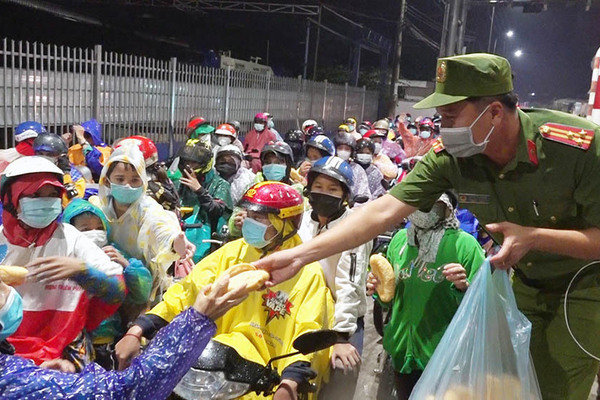When tens of thousands of people began leaving HCM City - Vietnam’s largest pandemic hotspot – on motorbikes on the night of October 1, it became obvious that under the pressure of being unemployed and the need for survival, migrant workers felt they had to surrender after a long period of social distancing.
“We just want to go straight home. We have instant noodles, milk, and even gasoline, because we don't want to stop along the way to cause trouble for anyone. Upon arriving home, we will self-isolate for 17 days, 21 days or a month, it doesn't matter," said a worker, who was stuck at a checkpoint in the night.
“After four months, everyone finally chose to go home. Don't blame them. Losing their job and getting VND1.5 or VND2.5 million allowance, but living in this city for four months is not something everyone can do. Anyway, the homeland will be gentle with everyone's life, food and clothing," Luong Nguyen Hoa Thuong commented during the forum "I am a Saigonese" when he saw the images of the migrants on the roads.
 |
|
Thousands of workers left Ho Chi Minh City on October 1 (photo: Phong Anh) |
Tran Viet Anh - General Director of Nam Thai Son Import-Export Joint Stock Company – said the labor force in HCM City can be divided into four groups: employees working for FDI enterprises; those working in industrial zones; laborers working outside industrial zones; and freelance workers. All four groups of workers live in high-population dormitories and often rent rooms of 10 square meters, shared by 10 people with five daytime workers and five night-time workers.
When the epidemic occurred, all 10 people were at home, so the 5K rules were almost ineffective. Infection cases appeared in these inns. In such a living environment, migrant workers lived in a state of anxiety and fear. They wanted to go home.
In addition, self-employed workers and workers outside industrial zones do not have access to specific information about their future life. Their employers could not answer the question of when will they can return to work, with normal wages. Thus, migrant workers looked back to their homeland, where life is safer now.
Le Minh Tan - Director of Ho Chi Minh City Department of Labor, War Invalids and Social Affairs - said that in the past 5 months, the number of employees receiving unemployment insurance has been over 100,000 people.
The solution to disruption of the labor market
At the online talks entitled "Labor resources for Ho Chi Minh City and neighboring provinces after the pandemic" organized on October 1, Director of the Employment Agency of the Ministry of Labor, War Invalids and Social Affairs Vu Trong Binh pointed out that many workers were leaving Ho Chi Minh City, Binh Duong, and Dong Nai (covid-19 hotspots) due to exhaustion and no income. Returning to work when there are still risks, they will be very hesitant, he said.
Moreover, when migrant workers return to their hometown in late months of the year, they will stay to celebrate the lunar New Year (Tet) and will not come back to HCM City for a few months, especially if the city has not yet controlled the disease.
According to Binh, the policy to build housing for workers in industrial zones has been implemented very slowly. During the pandemic, it is easy to see that most migrant workers do not settle down, so they do not feel secure while working.
“There should be a land fund to build housing for workers so that they can feel secure at work. It is very simple for a young worker to go to big cities to start a business alone. But when he marries and have children, there are many other concerns," Binh said.
 |
|
The decision of migrant workers to leave the city will cause disruption of human resources for the "new normal". (photo: Phong Anh)
|
Tran Viet Anh - General Director of Nam Thai Son Import-Export Joint Stock Company - said that if HCM City wants to keep migrant workers, it needs to join businesses to build housing for them in accordance with the living environment and health safety standards.
In addition, during this time, businesses must regularly contact their workers and encourage them to return. When they return, it is necessary to have connectionsbetween localities to open doors to workers.
At the same time, the local government and businesses should work together to keep workers in the city by giving them transparent information: For example, workers will be fully vaccinated with two vaccine doses and they will be able to work normally; the whole factory has been disinfected or has a medical room, equipped with oxygen tanks, SPO2 meters, where workers will be tested when necessary. These all make employees feel secure at work.
Ho Thi Thu Uyen, Director of External Relations at Intel Vietnam, proposed that HCM City’s neighboring provinces such as Dong Nai and Binh Duong allow qualified workers in high-tech zones to return to their home and go to work from home. This is an essential and urgent need of "3-on-the-spot" workers, who have been away from home for the past few months. To implement this, enterprises must have plans to ensure safe production according to the city's criteria.
Vu Minh Tien, Director of the Institute of Workers and Trade Unions of the Vietnam General Confederation of Labor, said the top priority is still to fully vaccinate workers.
“Businesses also need to pay attention to increase wages and benefits so that employees have higher incomes and better lives when working in the city," he said.
Tran Chung

Tens of thousands of people leave epidemic-hit areas to return to their hometowns
The huge flow of people leaving Vietnam’s Covid-19 hotspots to their hometowns in southwestern provinces has overloaded concentrated quarantine zones, where infection cases have been detected.